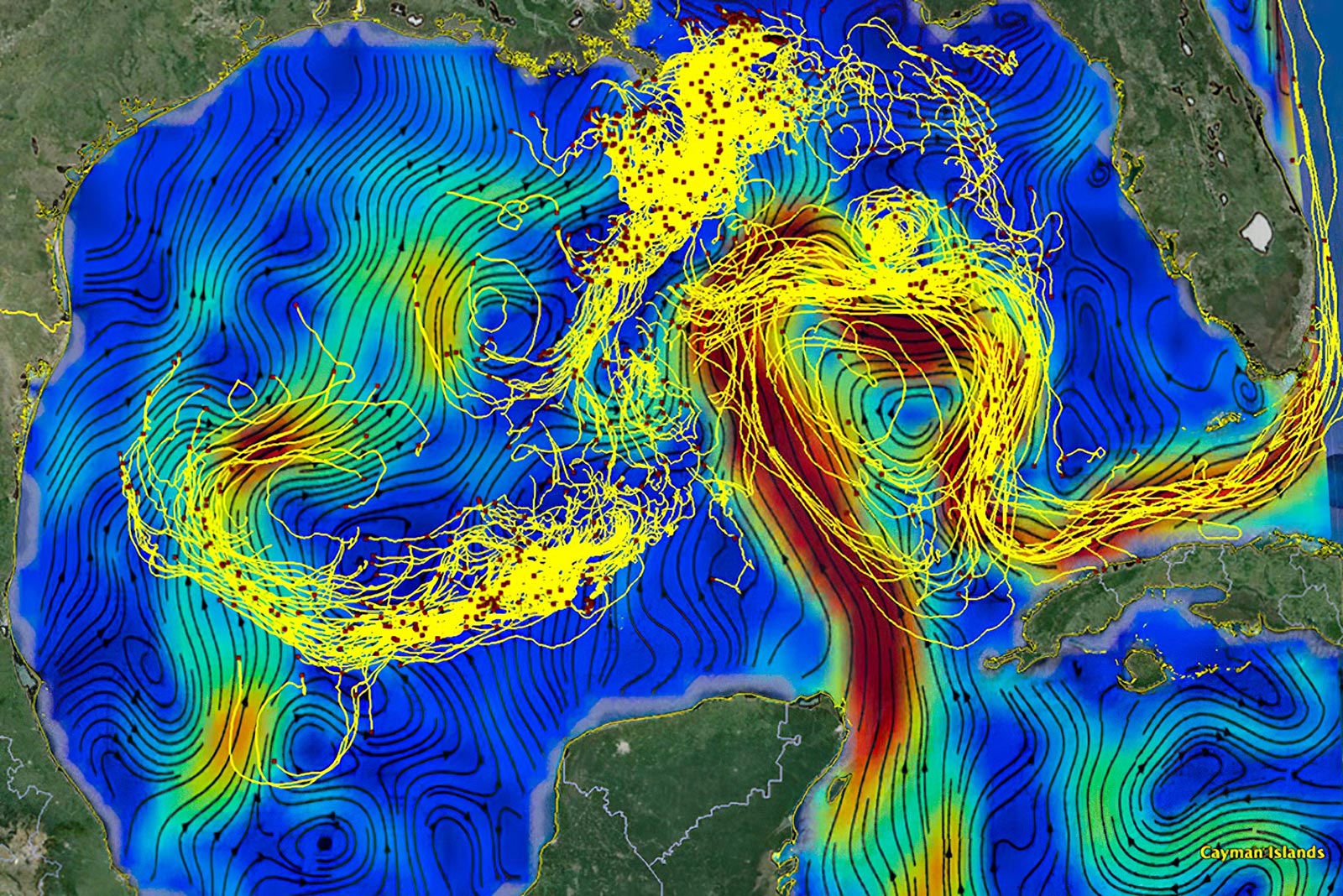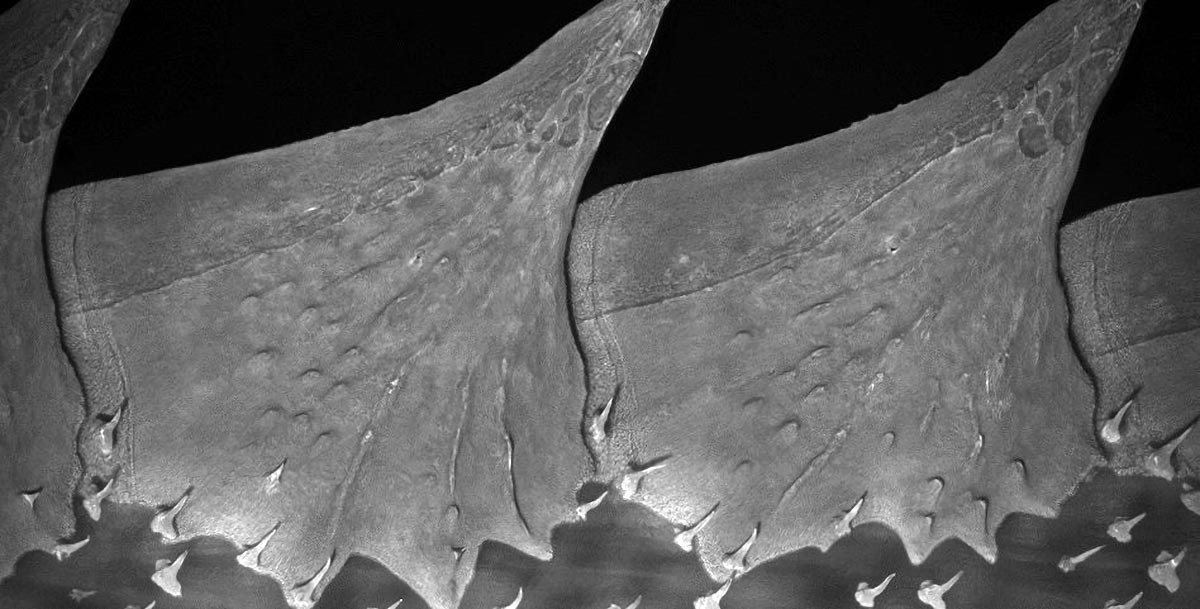Une meilleure façon d’étudier les courants océaniques


Des informaticiens du MIT ont collaboré avec des océanographes pour développer un modèle d’apprentissage automatique qui intègre les connaissances de la dynamique des fluides pour générer des prédictions plus précises sur les vitesses des courants océaniques. Cette figure montre les trajectoires des bouées dérivantes dans le golfe du Mexique superposées aux courants de surface. Les points rouges indiquent les positions des flotteurs le 9 mars 2016 et la queue mesure 14 jours. Crédit : Edward Ryan et Tamai Ozgukman de l’Université de Miami
Un nouveau modèle d’apprentissage automatique fait des prédictions plus précises sur les courants océaniques, ce qui peut aider à suivre la pollution plastique et les déversements de pétrole, et aider à la recherche et au sauvetage.
Pour étudier les courants océaniques, les scientifiques lancent[{ » attribute= » »>GPS-tagged buoys in the ocean and record their velocities to reconstruct the currents that transport them. These buoy data are also used to identify “divergences,” which are areas where water rises up from below the surface or sinks beneath it.
By accurately predicting currents and pinpointing divergences, scientists can more precisely forecast the weather, approximate how oil will spread after a spill, or measure energy transfer in the ocean. A new model that incorporates machine learning makes more accurate predictions than conventional models do, a new study reports.
A multidisciplinary research team including computer scientists at MIT and oceanographers has found that a standard statistical model typically used on buoy data can struggle to accurately reconstruct currents or identify divergences because it makes unrealistic assumptions about the behavior of water.
The researchers developed a new model that incorporates knowledge from fluid dynamics to better reflect the physics at work in ocean currents. They show that their method, which only requires a small amount of additional computational expense, is more accurate at predicting currents and identifying divergences than the traditional model.
This new model could help oceanographers make more accurate estimates from buoy data, which would enable them to more effectively monitor the transportation of biomass (such as Sargassum seaweed), carbon, plastics, oil, and nutrients in the ocean. This information is also important for understanding and tracking climate change.
“Our method captures the physical assumptions more appropriately and more accurately. In this case, we know a lot of the physics already. We are giving the model a little bit of that information so it can focus on learning the things that are important to us, like what are the currents away from the buoys, or what is this divergence and where is it happening?” says senior author Tamara Broderick, an associate professor in MIT’s Department of Electrical Engineering and Computer Science (EECS) and a member of the Laboratory for Information and Decision Systems and the Institute for Data, Systems, and Society.
Broderick’s co-authors include lead author Renato Berlinghieri, an electrical engineering and computer science graduate student; Brian L. Trippe, a postdoc at Columbia University; David R. Burt and Ryan Giordano, MIT postdocs; Kaushik Srinivasan, an assistant researcher in atmospheric and ocean sciences at the University of California at Los Angeles; Tamay Özgökmen, professor in the Department of Ocean Sciences at the University of Miami; and Junfei Xia, a graduate student at the University of Miami. The research will be presented at the International Conference on Machine Learning.
Diving into the data
Oceanographers use data on buoy velocity to predict ocean currents and identify “divergences” where water rises to the surface or sinks deeper.
To estimate currents and find divergences, oceanographers have used a machine-learning technique known as a Gaussian process, which can make predictions even when data are sparse. To work well in this case, the Gaussian process must make assumptions about the data to generate a prediction.
A standard way of applying a Gaussian process to oceans data assumes the latitude and longitude components of the current are unrelated. But this assumption isn’t physically accurate. For instance, this existing model implies that a current’s divergence and its vorticity (a whirling motion of fluid) operate on the same magnitude and length scales. Ocean scientists know this is not true, Broderick says. The previous model also assumes the frame of reference matters, which means fluid would behave differently in the latitude versus the longitude direction.
“We were thinking we could address these problems with a model that incorporates the physics,” she says.
They built a new model that uses what is known as a Helmholtz decomposition to accurately represent the principles of fluid dynamics. This method models an ocean current by breaking it down into a vorticity component (which captures the whirling motion) and a divergence component (which captures water rising or sinking).
In this way, they give the model some basic physics knowledge that it uses to make more accurate predictions.
This new model utilizes the same data as the old model. And while their method can be more computationally intensive, the researchers show that the additional cost is relatively small.
Buoyant performance
They evaluated the new model using synthetic and real ocean buoy data. Because the synthetic data were fabricated by the researchers, they could compare the model’s predictions to ground-truth currents and divergences. But simulation involves assumptions that may not reflect real life, so the researchers also tested their model using data captured by real buoys released in the Gulf of Mexico.
In each case, their method demonstrated superior performance for both tasks, predicting currents and identifying divergences, when compared to the standard Gaussian process and another machine-learning approach that used a neural network. For example, in one simulation that included a vortex adjacent to an ocean current, the new method correctly predicted no divergence while the previous Gaussian process method and the neural network method both predicted a divergence with very high confidence.
The technique is also good at identifying vortices from a small set of buoys, Broderick adds.
Now that they have demonstrated the effectiveness of using a Helmholtz decomposition, the researchers want to incorporate a time element into their model, since currents can vary over time as well as space. In addition, they want to better capture how noise impacts the data, such as winds that sometimes affect buoy velocity. Separating that noise from the data could make their approach more accurate.
“Our hope is to take this noisily observed field of velocities from the buoys, and then say what is the actual divergence and actual vorticity, and predict away from those buoys, and we think that our new technique will be helpful for this,” she says.
“The authors cleverly integrate known behaviors from fluid dynamics to model ocean currents in a flexible model,” says Massimiliano Russo, an associate biostatistician at Brigham and Women’s Hospital and instructor at Harvard Medical School, who was not involved with this work. “The resulting approach retains the flexibility to model the nonlinearity in the currents but can also characterize phenomena such as vortices and connected currents that would only be noticed if the fluid dynamic structure is integrated into the model. This is an excellent example of where a flexible model can be substantially improved with a well thought and scientifically sound specification.”
Reference: “Gaussian processes at the Helm(holtz): A more fluid model for ocean currents” by Renato Berlinghieri, Brian L. Trippe, David R. Burt, Ryan Giordano, Kaushik Srinivasan, Tamay Özgökmen, Junfei Xia and Tamara Broderick, 20 February 2023, Statistics > Methodology.
arXiv:2302.10364
This research is supported, in part, by the Office of Naval Research, a National Science Foundation (NSF) CAREER Award, and the Rosenstiel School of Marine, Atmospheric, and Earth Science at the University of Miami.



/cloudfront-us-east-2.images.arcpublishing.com/reuters/W6BWTIAFPJLYDE2TDD4EMN4EDQ.jpg)

